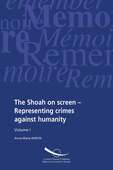Publications
This section offers a collection of resources on Holocaust remembrance, education, and research. This includes scholarly works, educational tools and survivor testimonies.
These publications reflect the Council of Europe's commitment to preserving the memory of the Holocaust and fostering a globally informed society rooted in dignity and justice. Educators, researchers, and all interested individuals are invited to explore and use these materials.
Click on each item below for more details and download links.
Sport in nazis camps
Educational kit
Roma history factsheets

This collection of pedagogical fact sheets on Roma history is available in Albanian, English, French, German, Italian, Romani, Romanian, Serbian and Swedish.
See, among others, sheet 5.0 Holocauste
Queer in Europe during the Second World War
At the height of the Second World War, Switzerland decriminalised homosexuality. At the same time, France chose to introduce a law punishing homosexual relationships in certain circumstances. These two examples illustrate contradictory attitudes adopted by European states towards homosexuals during the Second World War.
Going beyond the issue of the persecution of homosexuals and the central role played by Nazi Germany between 1939 and 1945, this book is the first to examine the daily lives of homosexual men and women in wartime. By bringing together European specialists on the subject, it relates a different history, one which was indeed marked by repression but also by enlistment in armies at war and resistance groups, not to mention collaboration. Chapter by chapter, it enables us to better understand why the Second World War was a turning point for gays and lesbians in Europe and why our continent is a leader in the fight against discrimination.
For the Council of Europe, this book contributes to two separate programmes, the Passing on the Remembrance of the Holocaust and Prevention of Crimes against Humanity programme and the Promoting Human Rights and Equality for LGBT People programme, within the framework of Committee of Ministers Recommendation CM/Rec(2010)5 on combating discrimination on grounds of sexual orientation or gender identity programme. It also continues work towards acknowledging all of the victims of the Nazi regime.
*Régis Schlagdenhauffen is a lecturer at the École des hautes études en sciences sociales (EHESS), head of the gender-based social history department, member of the Laboratory of Excellence “Writing a new history of Europe” (LabEx EHNE) and co-author of the Council of Europe pedagogical factsheets for teachers entitled “Victims of Nazism. A mosaic of fates” (2015).
La musique dans le système concentrationaire nazi
(only in French)

(French only)
Presented by Amaury Du Closel
Victims of Nazism – A mosaic of Fates
Pedagogical Factsheets for teachers

These education factsheets on the different categories of Nazi victims are designed to help teachers prepare their lessons on the history and remebrance of the Holocaust. Each sheet gives an overview of the Nazi persecution of a specific victim group.
European Pack for visiting Auschwitz-Birkenau Memorial and Museum
Guidelines for Teachers and Educators

Taking groups of students to the Auschwitz-Birkenau Memorial and Museum is a heavy responsibility, but it is a major contribution to citizenship if it fosters understanding of what Auschwitz stands for, particularly when the last survivors are at the end of their lives. It comes with certain risks, however.This pack is designed for teachers wishing to organise student visits to authentic places of remembrance, and for the guides, academics and others who work every day with young people at Auschwitz.
The Shoah on screen - Representing crimes against humanity

In attempting to portray the Holocaust and crimes against humanity on the big screen, film-makers generally have to address the key question of realism. This is both an ethical and an artistic issue. The full range of approaches has been adopted, covering documentaries and fiction, historical reconstructions such as Steven Spielberg's Schindler's List, depicting reality in all its details, and more symbolic films such as Roberto Benigni's Life is beautiful. Some films have been very controversial, and it is important to understand why.Is cinema the best way of informing the younger generations about what took place, or should this perhaps be left, for example, to videos or archive collections? What is the difference between these and the cinema as an art form? Is it possible to inform and appeal to the emotions without being explicit? Is emotion itself, though often very intense, not ambivalent? These are the questions addressed by this book which sets out to show that the cinema, a major art form today, cannot merely depict the horrors of concentration camps but must also nurture greater sensitivity among increasingly younger audiences, inured by the many images of violence conveyed in the media.
Teaching about the Holocaust in the 21st century
Teaching Pack

This teaching pack, based on the work of such widely recognised authors as Raul Hilberg, Sir Martin Gilbert, Saul Friedlander and Christopher Browning, plus first-hand accounts, including those of Primo Levi, Hermann Langbein and Claude Lanzmann's interviewees, offers teachers a body of knowledge for use in course planning. Included is a certain amount of material about the nature and implementation of the genocide in different countries. Beyond any specific local characteristics, what emerges from the succinct descriptions of how and where this genocide was carried out is the comprehensiveness of the nazi enterprise.







